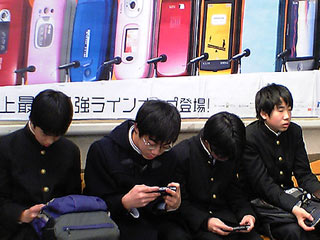 As mobile music settles into a steady mainstream growth cycle, with now-well-established hardware and content offerings, many industry watchers are looking towards the Next Big Thing. We think they need look no further than portable gaming, which is set to take mobile by storm. All the ingredients for mobile gaming success are in place: key platforms, faster 3G networks, affordable and flat-rate data, and a keen, heavy using youth demographic that continues to display a never-ending quest for hardware upgrades. Take a look around the streets of Tokyo, and the conclusion is unmissable: gaming for mobile devices is set for impressive growth in the next few years.
As mobile music settles into a steady mainstream growth cycle, with now-well-established hardware and content offerings, many industry watchers are looking towards the Next Big Thing. We think they need look no further than portable gaming, which is set to take mobile by storm. All the ingredients for mobile gaming success are in place: key platforms, faster 3G networks, affordable and flat-rate data, and a keen, heavy using youth demographic that continues to display a never-ending quest for hardware upgrades. Take a look around the streets of Tokyo, and the conclusion is unmissable: gaming for mobile devices is set for impressive growth in the next few years.
To date, the limiting factor has been the actual devices, as it was at one stage with music. The Nintendo DS and Sony PSP, much like Apple’s iPod, have proven to be early major hits as stand-alone units, having sufficient onboard CPU and memory capabilities to run some intensive games. In view of the success of porting the well-known ‘Walkman‘ onto mobile phones, can it be that long before we see the PSP label on a prototype cell phone from Sony Ericsson?
The photo tells it all. Taken recently by WWJ digital media director Lawrence Cosh-Ishii in suburban Tokyo, it shows a group of mid-teen boys waiting for a train at Shimo-Kitazawa station; all are playing with a PSP, blissfully ignorant of the huge poster for KDDI/au’s new music campaign. Note also that the recent BREW 2006 Conference issued a release with the news that Qualcomm and Microsoft will port MS ‘Live Anywhere’ for X-Box 360 gaming onto BREW-enabled mobile handsets. If you don’t think these tech giants have got it right, just watch what the kids are doing!


 As mobile music settles into a steady mainstream
As mobile music settles into a steady mainstream  This week marked a major milestone for WWJ! In one form or another, I’ve been writing this email newsletter for five years — and what a five year term it’s been!
This week marked a major milestone for WWJ! In one form or another, I’ve been writing this email newsletter for five years — and what a five year term it’s been!